Themed collection Most downloaded articles of 2017: Energy and Catalysis

Harnessing non-covalent interactions to exert control over regioselectivity and site-selectivity in catalytic reactions
This perspective examines the progress that has been made in using non-covalent interactions to control regioselectivity and site-selectivity in catalysis.

Chem. Sci., 2017,8, 864-877
https://doi.org/10.1039/C6SC04157D
Dual cobalt–copper light-driven catalytic reduction of aldehydes and aromatic ketones in aqueous media
A dual catalytic system based on earth-abundant elements reduces aromatic ketones and aldehydes to alcohols in aqueous media under visible light. An unprecedented selectivity for the reduction of aromatic ketones versus aliphatic aldehydes is reported.
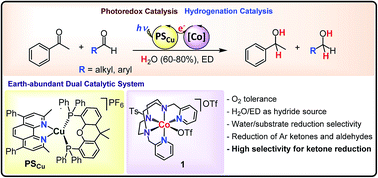
Chem. Sci., 2017,8, 4739-4749
https://doi.org/10.1039/C7SC01276D
Metal-free direct alkylation of unfunctionalized allylic/benzylic sp3 C–H bonds via photoredox induced radical cation deprotonation
An unprecendented direct alkylation of unfunctionalized allylic/benzylic sp3 C–H bonds via photoredox induced radical cation deprotonation is disclosed.

Chem. Sci., 2017,8, 4654-4659
https://doi.org/10.1039/C7SC00953D
Catalytic asymmetric synthesis of CF3-substituted tertiary propargylic alcohols via direct aldol reaction of α-N3 amide
The catalyst comprising Cu(II)/chiral hydroxamic acid was found to play a bifunctional role in the direct aldol reaction of α-N3 amide to alkynyl CF3 ketones.
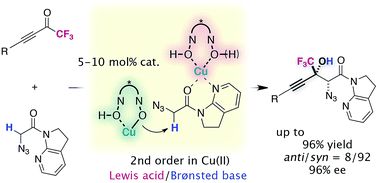
Chem. Sci., 2017,8, 3260-3269
https://doi.org/10.1039/C7SC00330G
Sub-1.1 nm ultrathin porous CoP nanosheets with dominant reactive {200} facets: a high mass activity and efficient electrocatalyst for the hydrogen evolution reaction
We present a convenient chemical conversion strategy for the synthesis of CoP porous ultrathin nanosheets as highly efficient catalysts for the hydrogen evolution reaction.

Chem. Sci., 2017,8, 2769-2775
https://doi.org/10.1039/C6SC05687C
Cobalt catalyzed carbonylation of unactivated C(sp3)–H bonds
A general efficient regioselective cobalt catalyzed carbonylation of unactivated C(sp3)–H bonds of aliphatic amides was demonstrated using atmospheric (1–2 atm) carbon monoxide as a C1 source.

Chem. Sci., 2017,8, 2431-2435
https://doi.org/10.1039/C6SC05026C
Postsynthetic ionization of an imidazole-containing metal–organic framework for the cycloaddition of carbon dioxide and epoxides
A bifunctional imidazolium functionalized Zr-based metal–organic framework, (I−)Meim-UiO-66, was successfully prepared, which can serve as an efficient heterogeneous catalyst towards the capture and coupling of CO2 with epoxides.
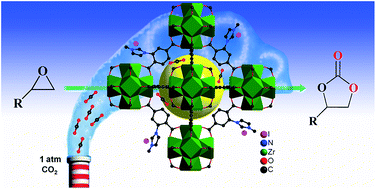
Chem. Sci., 2017,8, 1570-1575
https://doi.org/10.1039/C6SC04357G
Co/NHPI-mediated aerobic oxygenation of benzylic C–H bonds in pharmaceutically relevant molecules
A new method for Co/NHPI-catalyzed aerobic C–H oxygenation shows excellent tolerance of electronically diverse heterocycles.
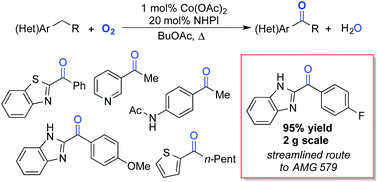
Chem. Sci., 2017,8, 1282-1287
https://doi.org/10.1039/C6SC03831J
Single-atom catalysts for CO2 electroreduction with significant activity and selectivity improvements
We propose the great potential of single atom catalysts (SACs) for CO2 electroreduction with high activity and selectivity predictions over a competitive H2 evolution reaction. We find the lack of an atomic ensemble for adsorbate binding and unique electronic structure of the single atom catalysts play an important role.

Chem. Sci., 2017,8, 1090-1096
https://doi.org/10.1039/C6SC03911A
Porous dendritic copper: an electrocatalyst for highly selective CO2 reduction to formate in water/ionic liquid electrolyte
An ionic liquid/water electrolyte promotes excellent selectivity for CO2 electroreduction to formic acid at a porous dendritic copper electrode material.
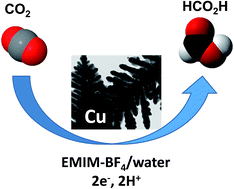
Chem. Sci., 2017,8, 742-747
https://doi.org/10.1039/C6SC03194C
Indolo[3,2-b]indole-based crystalline hole-transporting material for highly efficient perovskite solar cells
A fluorinated indolo[3,2-b]indole (IDID) derivative is prepared as a crystalline hole transporting material for perovskite solar cells. A fluorinated IDID backbone enables a tight molecular stacking by π–π interaction. The device fabricated using IDIDF exhibits a PCE of 19%.
![Graphical abstract: Indolo[3,2-b]indole-based crystalline hole-transporting material for highly efficient perovskite solar cells](/en/Image/Get?imageInfo.ImageType=GA&imageInfo.ImageIdentifier.ManuscriptID=C6SC02832B&imageInfo.ImageIdentifier.Year=2017)
Chem. Sci., 2017,8, 734-741
https://doi.org/10.1039/C6SC02832B
About this collection
We are delighted to present a collection showcasing some of the most downloaded Chemical Science articles of 2017. This provides an easy way to quickly access the most important papers published in Chemical Science this year. These articles highlight exciting and impactful research across a broad range of subject areas, consisting of analytical chemistry, chemical biology, catalysis, energy, inorganic chemistry, materials science, nanoscience, organic chemistry and physical chemistry. We hope you enjoy reading this collection!